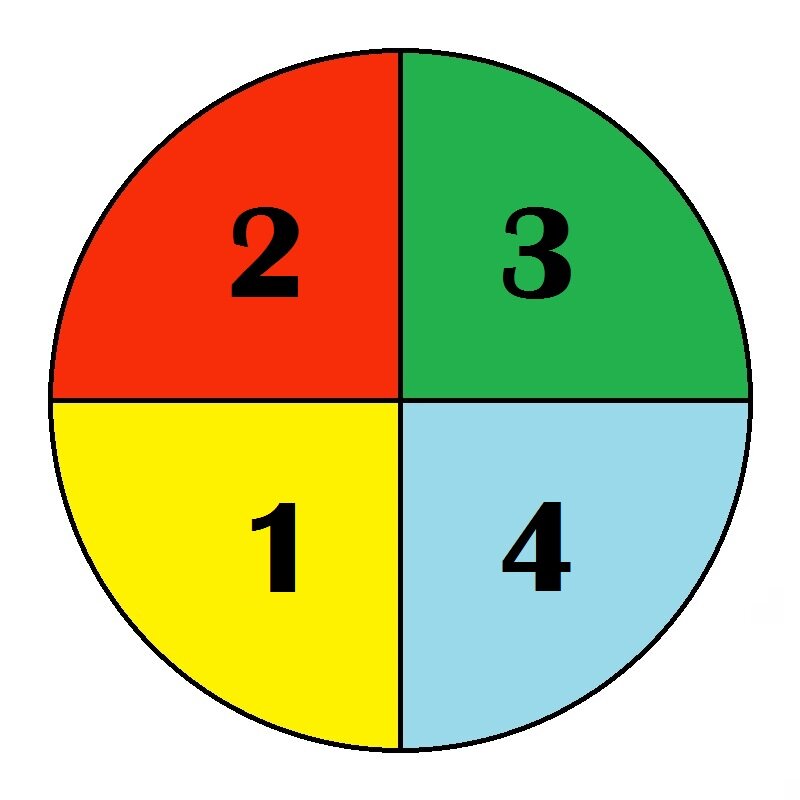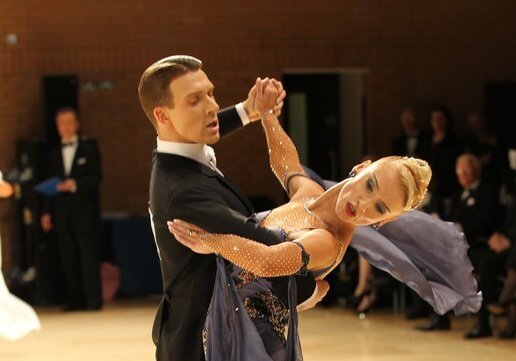The 4 Quadrants of Head Weight 
6 May 2016
Head weight is typically not something that is taught until after a few years of dancing, but a thorough understanding of it can revolutionize your dancing. The principle is that due to the Lady's extreme posture, the weight of her head is significant during rotation and extension, and it can actually be used as a counterbalance to make dancing easier. There are countless things that can be said about head weight, but this article will discuss the four quadrants.
The Four Quadrants
Imagine that the partnership is divided by a giant plus sign, with one bar splitting the Man from the Lady, running parallel to and between their shoulders, and the other bar running right through the point of connection of the Man and Lady's right side. What you would have would be four quadrants.
| Quadrant 1 | Here is the majority of the Man's body, with his head stretched diagonally back and to his left, away from the centre of the circle. |
| Quadrant 2 | Here is the Lady's right arm. |
| Quadrant 3 | Here is the majority of the Lady's body, with her head stretched diagonally back and to her left, away from the centre of the circle. The Man's right forearm is also in this quadrant, resting on her shoulder blade. |
| Quadrant 4 | Here is the Man's right upper arm, and the Lady's left forearm. |

But there is more to the quadrant system than just the plus sign - there is also the circle. You should feel that your head weight rests on the outside edge of the circle, and your partner's head weight counterbalances you. Wherever you move, whenever you turn, your partner maintains that counterbalance.
The Three Rules of the Quadrants
Here are the three rules of the quadrant system.
1) The Man's head weight belongs in quadrant 1, and the Lady's in quadrant 3.
2) Wherever the Man's head weight goes, the Lady's head weight must flee diagonally across to the opposite quadrant.
3) Always stay as far from the centre of the circle as possible
These three rules are very important, and they are always true 100% of the time, unless they're not. As you will see, there are specific instances where we will break every one of these rules, but in 90% of cases these rules will be followed.
Moving Up a Quadrant
Let's start off by breaking the first rule. When dancing a figure with a Natural rotation (i.e. to the right), the Man will stretch forward to quadrant 2, and the Lady (following rule 2) will stretch to quadrant 4. In fact, it won't be just the head weight, but their entire bodies will twist clockwise, with their heads at the end of that twist and therefore showing the most movement. This shift is actually what is known as CBM, or contra body movement, and it is what will power the rotation. Bear in mind rule 3, which states that even though we are moving from one quadrant to another, the head weight needs to stay toward the outside of the circle, so it doesn't just go straight forward. Whether it be a Natural Turn, a Natural Promenade Turn, or even a Feather Step, feel that you stretch diagonally forward on Natural figures.
If we go up a quadrant when turning to the right, what happens when turning to the left? Do we go down a quadrant? Absolutely not! If you do that, you will lose offset and you will find yourself falling through the turn. When turning to the left, maintain your quadrant. It doesn't matter what the figure is - a Reverse Turn, a Double Reverse Spin, a Fallaway Reverse & Slip Pivot - maintain your quadrant and stay on the outside of the circle with your head weight!
Moving Down a Quadrant
Generally, if the Man moves to quadrant 4 and the Lady responds appropriately by moving to quadrant 2, the couple will lose offset. However, there are some instances where position changes make this appropriate. In certain line figures, such as the Left Whisk or Throwaway Oversway,, the Man will bring his head weight back and around the circle to quadrant 4, and the Lady will travel back and around to quadrant 2.

On these figures especially it is important that a constant counterbalance is felt between the head weight of the Man and Lady, in order to maintain balance during the line figure.
Moving Across a Quadrant
We have seen the Man move to quadrant 2 and quadrant 4, but not to quadrant 3 where the Lady generally belongs. We have also not broken rules 2 and 3 yet, so let's get to it. When dancing a contra check, or other figures that have the Lady doing an extreme shape backward, the Man will break rule 3 and go straight through the centre of the circle into the Lady's space in quadrant 3. In this case, the Lady couldn't possibly go to the opposite quadrant, so she moves straight back into her shape. Beware of this, however, because it can go horribly wrong. Although the Man is moving into quadrant 3, he isn't really hunching his head forward, as a beautiful backward posture needs to be maintained. Likewise, it is important that the Lady send her head weight backward to the extreme, but not her body weight, which should be reaching diagonally upward toward the Man.

There you have it, the four quadrants of height weight and the ways to use them in your dancing. During your next practice, experiment with a constant counterbalance in your head weights, and rotating that from one quadrant to another as you dance. Notice how it changes your dancing, making rotations easier, making shapes bigger and more beautiful, and making your partnership more comfortable.